By Brian Roewe and Chris Herlinger
On a morning in July, after a night of heavy rains in New York's Hudson Valley, a path cutting through 42 acres of wetland and woodland owned by the Maryknoll Sisters was a verdant green.
Leaves glistened, and spots of mud dotted the path.
Sr. Doreen Longres, carrying a weeding hoe, paused and contemplated the significance of the acreage, which constitutes about two-thirds of the congregation’s 62-acre center outside Ossining, New York.
"This land has been so important to us," Longres said. "The land contains connectedness."
That connectedness extends beyond the sisters' own relationship to the property that, for more than a century, has served as the spiritual and working center for a congregation with a mission in 18 countries around the world.
That connectedness extends to the Earth itself — a belief grounded in an ethic of protection and care.
"We believe that creation is a primary source of revelation of the Divine Presence. Earth is sacred, and the extinction of life forms and ecosystems through overuse and irresponsible exploitation is a destruction of manifestations of the Divine Presence," the sisters said in a 2006 land ethic statement.
With that as a foundation, the Maryknoll Sisters made their belief even more concrete. Almost a decade ago, in 2012, the congregation entered into a land preservation agreement with a local group, the Westchester Land Trust, setting aside 42 acres as protected land — "forever wild" — in perpetuity through a conservation easement.
The easement means that the sisters have agreed that the land will not be developed. In turn, the local land trust safeguards the land through annual visits.
The Catholic Church is one of the world's largest nongovernmental landholders, and as religious communities age and face higher health care costs for their members, their real estate is an important asset that could provide significant revenue if sold for development. Nevertheless, many religious congregations are choosing to conserve some of their land permanently, to safeguard water sources, protect biodiversity, and buffer against both urban sprawl and climate change, and to express their commitment to caring for creation.
When the Maryknoll Sisters decided to establish the conservation easement, Sr. Janice McLaughlin, then president of the congregation, called the agreement "a sacred trust," while Candace Schafer, the director of the land trust, noted that "conservation is an act of faith" and said the agreement memorializes "forever the love and respect you have for the land that supports your community."
It's a peaceful place... but it's also prime property in the middle of the city, and it would be valuable real estate. That isn't what we want to have happen with it."
Franciscan Sr. Ramona Miller
I know forever is a very long time, but that's kind of what we're saying in this easement, is it will be forever. At least, it's our best shot at forever."
Mercy Sr. Catherine Kuper
Earth is sacred, and the extinction of life forms and ecosystems through overuse and irresponsible exploitation is a destruction of manifestations of the Divine Presence."
Maryknoll Sisters land ethic statement
The Maryknoll easement was among the first protections of congregational lands against development, but it was not the only one. At least three other congregations in the Hudson Valley have similar agreements with conservation or government groups. And other congregations there and elsewhere in the country have initiated projects to protect land, including the development of environmentally friendly community farms and gardens.
In the Midwest alone, congregations of Franciscans, Sisters of Mercy, Sisters of St. Joseph and more have moved to preserve the land that has cultivated decades, and sometimes more than a century, of ministry and spirituality. They're part of a wider conservation movement across the country as religious communities ponder how best to manage the land and maintain it in its natural state — for the sisters, as God created it — long after they're gone.
More than 56 million acres in the U.S. have been conserved through land trusts, according to the Land Trust Alliance, a national conservation nonprofit organization. As a whole, the country comprises 2.27 billion acres, of which roughly 28% is owned by the federal government.
While there are differences in approach and focus, the Catholic congregations promoting conservation share the view that the land itself is sacred and its value extends beyond what one can do or build upon it.
"We have such a utilitarian kind of mindset — especially, I think, as Americans — that if something can be used for something, it ought to be," said Franciscan Sr. Charlotte Hesby, who worked to establish an easement at the Assisi Heights motherhouse in Rochester, Minnesota. "A lake is only valuable if you can fish in it, if you can use it for recreation. If a rare species is there, then it's OK to preserve it. But otherwise we don't see it as having a value in and of itself."
Franciscan Sisters
Area protected: 72 acres of 116 total
Form of protection: Conservation easement
Franciscan Sisters
of Perpetual Adoration
Area protected: 200 acres, for different uses
Form of protection: Collaborative environmental sustainability project
Franciscan Sisters
Area protected: 68 acres of 130 total
Form of protection: Conservation easement

From their hillside motherhouse, Assisi Heights, the Sisters of St. Francis can see the skyline of downtown Rochester, Minnesota. When they moved to this area in 1949, it was outside the city limits, but the urban area has grown, and they are once again near the city center.
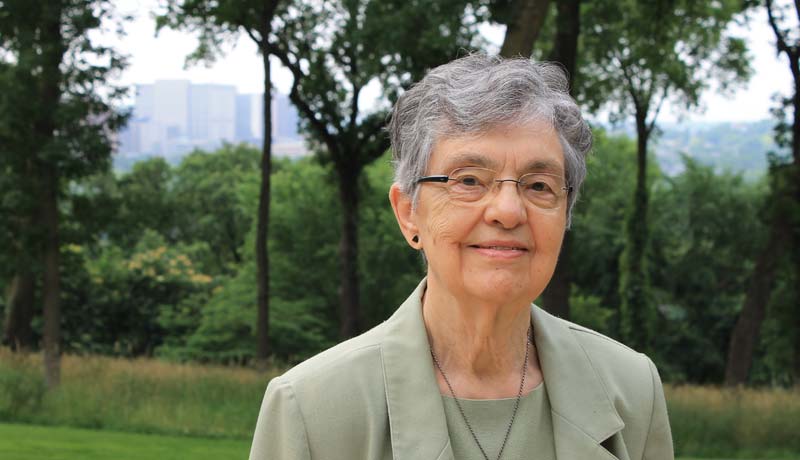
Sr. Ramona Miller, president and congregational minister of the Sisters of St. Francis of Rochester, Minnesota, stands near the Assisi Heights motherhouse with the downtown Rochester skyline in the background. (Photo by Brian Roewe)
That has made the sisters' property prime real estate, particularly for housing with a view. But the sisters have no intention of selling.
In July 2019, the Rochester Franciscans approved a conservation easement for 72 of their 116 acres. The land in the easement faces south, toward downtown and the rest of Rochester.
"This southern slope is the face to the public that they see. And it was part of the aesthetic reason of holding this [land] and saying we don't want this marred. This is really beautiful," Sr. Ramona Miller, president and congregational minister, said.
"It's prime property in the middle of the city, and it would be valuable real estate. That isn't what we want to have happen with it," she added. "So the conserving of land and not just turning all land over to apartment buildings or some other valuable service here is a statement in itself about protecting land."
The Franciscan sisters at Assisi Heights said they have long desired to save this land. For many, it holds important spiritual value — Miller pointed to the accumulation of "prayer energy" in a space that for nearly 70 years has been where women religious have prayed and nurtured a deep sensitivity to nature.
The idea of a conservation easement emerged in 2017 as part of the congregation's long-range planning and conversations about the legacy they would like to leave when the last sister dies. They discussed other possibilities, such as building housing for the poor, but ultimately decided that "we don't want to give up this beauty," Miller told EarthBeat.
They settled on an easement, while also agreeing to put money toward housing in another area. They had earlier turned over parts of their land for residences for developmentally challenged adults and a nursing home that is now a rehab facility for people with chemical addictions.
The Rochester Franciscans explored easement options through the Minnesota Land Trust, but ultimately decided to establish their own foundation to oversee the easement. For the sisters, this unusual arrangement gave them added certainty that their wishes for the land would be honored forever.
"The joy when you come up [here], to say I know this is always going to be like this, the prairie is going to be down there, the green grass, that's a deep satisfaction," Miller said.
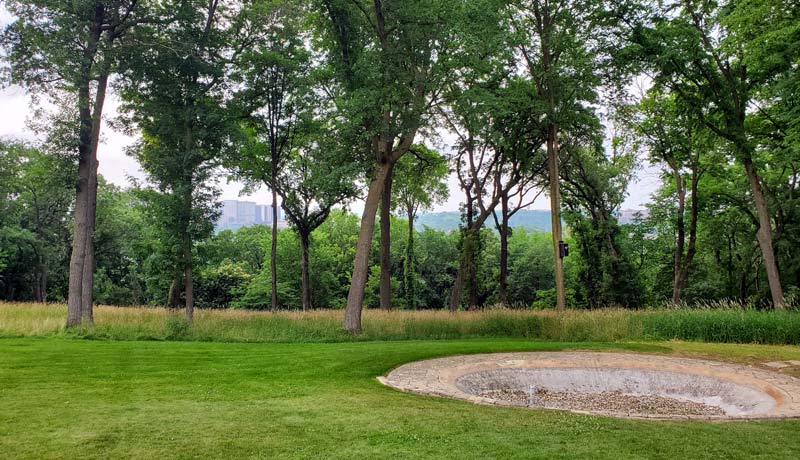
Beyond the Assisi Heights conservation easement, the downtown Rochester, Minnesota, skyline is visible in the distance. (Photo by Brian Roewe)

At Villa St. Joseph, land has become a living classroom. Ninety-two acres surrounding the villa, a retirement home for the Franciscan Sisters of Perpetual Adoration of La Crosse, Wisconsin, have been set aside for what the sisters call a collaborative educational sustainability project, where local people can apply to use small plots to grow their own food.
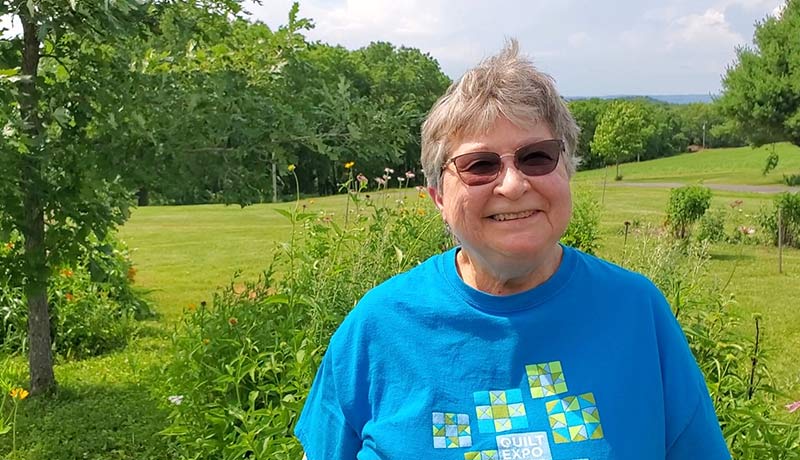
Franciscan Sr. Sharon Berger stands in front of the natural burial ground that is part of the conservation easement on the land of the Franciscan Sisters of Perpetual Adoration. (Photo by Brian Roewe)
They will begin taking applications in January 2022. Meanwhile, the sisters have partnered with local schools and universities on various projects on the villa's full 200 acres, located 11 miles east of La Crosse and the Mississippi River. There have been studies of mason bees, 4-H groups have grown micro greens in the winter, and participants have mapped the area's flora and fauna.
"People come to us with their needs, and we'll try to fill it with this as our classroom," said Beth Piggush, integral ecology director for the congregation.
A primary goal of the educational sustainability project is to provide access to land to those who may not have it. The land was set aside in perpetuity for this educational endeavor, but it is not in an easement.
"The sisters weren't ready for it," said Sr. Sharon Berger, a member of the congregation's land usage committee, who was on the ecospirituality committee in the mid-2000s, when the idea of a conservation easement through the Mississippi Valley Conservancy was first broached.
Some sisters feared that a conservation easement would tie the hands of younger sisters if they needed to sell the land in the future. Other concerns included determining how much of the land qualifies as church property, an important consideration for tax purposes. Wisconsin also requires that all conservation easements have some level of public access.
The villa is one of three nature-based properties the sisters own. Marywood Franciscan Spirituality Center sits on Trout Lake in Wisconsin's Northwoods. And at Prairiewoods, a spirituality center in Hiawatha, Iowa, in 2019 the sisters placed most of its 70 acres of woods and prairie into a conservation easement.
With no consensus for an easement in Wisconsin, the sisters are content to make the land available for community education related to sustainability. They also grow fruits, vegetables, walnuts and flowers for their own use. In 2009, a portion of the land, once the site of a dairy barn, became La Crosse County's first green burial space.
Many of the sisters grew up on farms, and they believe firmly that the connection they feel to the land is an important value to preserve and pass on to future generations.
"A lot of us grew up in rural areas. And we are very in touch with Earth, with being out and working in the ground," Berger said. "I think it's part of our DNA."
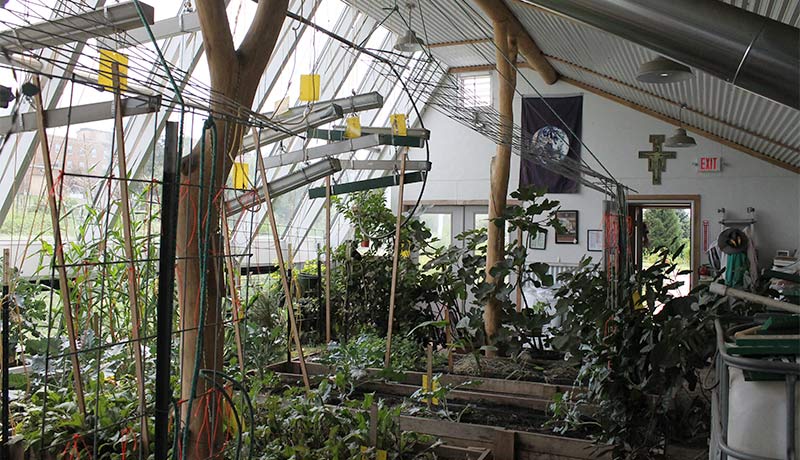
Jacoba's Greenhouse on the Franciscan Sisters' land near La Crosse, Wisconsin, is named for a companion of St. Francis of Assisi. (Photo by Brian Roewe)

Since the Sisters of St. Francis first arrived in the area around Dubuque, Iowa, in the 1870s, their land has been important to them. First they farmed it themselves, then they rented it to local farmers. In the late 1980s, they restored about 80 acres of prairie. Along the way they sold off some land for development projects in line with their ministry, and a retirement home and family townhouses are now neighbors.
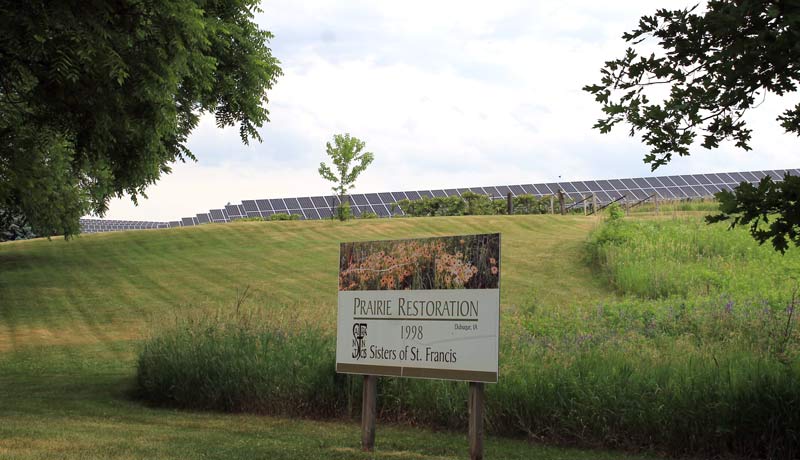
Native prairie grasses grow in the conservation easement established by the Sisters of St. Francis of Dubuque, Iowa. (Photo by Brian Roewe)
In May 2019, the sisters placed 68 acres — 55 acres of prairie and 13 of woodland — of their 130-acre property into a conservation easement with the Iowa Natural Heritage Foundation. The goal was simple, said Sr. Cathy Katoski, development director and past president of the Sisters of St. Francis: "To preserve our prairie."
"Since 1879 we have shared a unique relationship with this parcel of land on the north end of Dubuque. We were called to cherish and care for the gift of land entrusted to us, and as part of our legacy, we are now called to leave it for future generations," she said in a press release announcing the decision.
Just north of a new 2,600-panel solar array, the now-protected prairie is home to redwing blackbirds that swoop above the grasses where they make their nests. Sisters can stroll a peaceful mowed path to experience creation and the symphony of nature.
The decision to establish an easement was not difficult, Katoski said. Dubuque has grown mainly to the south and west, so developers weren't knocking on their door. And the sisters determined their financial situation was solid enough that they wouldn't have to tap into the land's financial value to sustain themselves in the future.
"We just [had] no need to sell it or have it developed — and didn't want anyone else to do so as well," she told EarthBeat.
The decision-making process was smooth, the sisters said, partly because of their Franciscan values and relationship with God's creation, and partly because of groundwork laid years earlier in two documents — a 1998 document titled "Our Covenant with Creation" and a subsquent land ethic statement — that helped guide land-use decisions.
In 1999, they placed 80 acres into the federal Conservation Reserve Program, in which landowners are paid not to farm environmentally sensitive land for 10 to 15 years and to plant species that will help reestablish land cover, improve water quality and mitigate climate change. That area was later reduced to 76 acres to accommodate the solar panels and a garden.
Discussion of an easement began in 2017 as part of the sisters' long-range planning. Representatives of the Des Moines-based Iowa Natural Heritage Foundation spoke at their fall congregational gathering that year, and the sisters approved the easement the following spring.
"We don't make these large decisions quickly," said Sr. Kathy Knipper, the congregation's president. "It's a collaborative process, and it happens over a long period of time with lots of input and consideration, prayer and reflection."
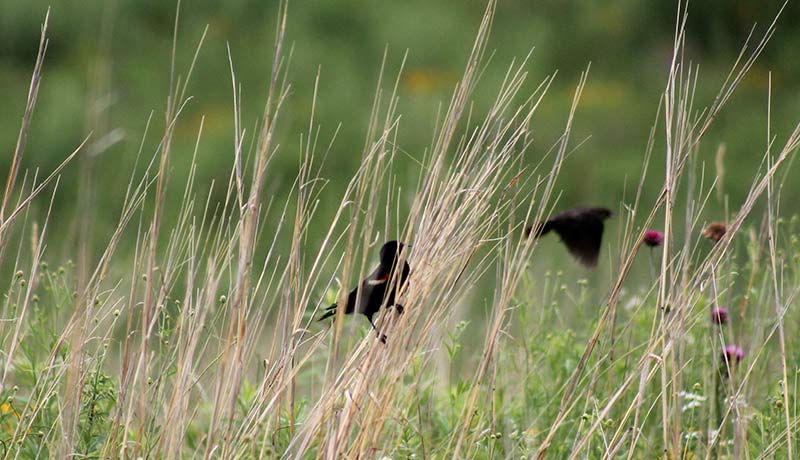
Redwing blackbirds are among the birds and other animals that make their home in the restored prairie. (Photo by Brian Roewe)
FRANCISCAN SISTERS / ROCHESTER, MINNESOTA
FRANCISCAN SISTERS OF PERPETUAL ADORATION / LA CROSSE, WISCONSIN
FRANCISCAN SISTERS / DUBUQUE, IOWA
The desire to conserve the land is driven by the congregation's charism. A deep dedication to caring for creation is embedded in countless congregations of women religious. This often predates by decades the teachings of Pope Francis, who has elevated environmental concerns within the church and on the world stage, most notably through his 2015 encyclical "Laudato Si', on Care for Our Common Home."
But there are other motivations, too.
Discussions about land preservation have regularly emerged during long-range planning by congregations, who recognize that their numbers are diminishing and there may come a time when the community no longer exists.
Sometimes a single sister has led land preservation efforts, and when she is no longer able to do so, turning part of the property over to a land trust allows conservation to continue. That was the case with Bow-in-the-Clouds Natural Area, now Bow-in-the-Clouds Preserve, which the Sisters of St. Joseph of Nazareth, Michigan, donated to the Southwest Michigan Land Conservancy more than a decade ago.
Often the sisters want to avoid having land they see as sacred become the next development project.From their hilltop Assisi Heights motherhouse, the Sisters of St. Francis have watched the city of Rochester creep closer and closer to their 116-acre property.
"It's a peaceful place … but it's also prime property in the middle of the city, and it would be valuable real estate. That isn't what we want to have happen with it," Sr. Ramona Miller, president and congregational minister of the Rochester Franciscans, said of their land.
"So the conserving of land and not just turning all land over to apartment buildings or some other valuable service here is a statement in itself about protecting land," she said.
That mindset has led many congregations to consider placing land in easements.
A conservation easement is a legal agreement that permanently limits how land can be — and, just as importantly, how it cannot be — used. Those terms are set by the landowner who initiates the easement and must be followed by any future owner of the property. Importantly, an easement does not preclude the ability to sell the land.
In many states, land trusts and conservancies provide resources to help landowners protect their land. They also conduct annual reviews to ensure the land is used according to the terms of the easement.
In Iowa, both the Franciscan Sisters of Dubuque and the Franciscan Sisters of Perpetual Adoration have entered into agreements with the Iowa Natural Heritage Foundation. And the Sisters of Mercy established a conservation easement with the Nebraska Land Trust for 25 acres of wooded land and a small pond just west of Omaha along the Platte River.
When the Sisters of Mercy leadership team approved the easement, the decision assured Sr. Catherine Kuper, who was long involved in environmental efforts with the land, that all forms of life there would continue to have a habitat.
"I know forever is a very long time, but that's kind of what we're saying in this easement, is it will be forever," she said.
"At least, it's our best shot at forever."
Maryknoll Sisters
Area protected: 42 acres of 67 total
Form of protection: Conservation easement
Dominican Sisters of Hope
Area protected: 34 acres of 61 total
Form of protection: Conservation easement
Sisters of Our Lady of Christian Doctrine
Area protected: 30 acres of 40 total
Form of protection: Sold to a land trust, which donated land to state to be added to parks

When the Maryknoll Sisters decided in 2012 to conserve 42 of their 67 acres of land near the Hudson River under an agreement with the Westchester Land Trust, it made them pioneers of a sort. Other congregations in the Hudson Valley region have since followed suit.
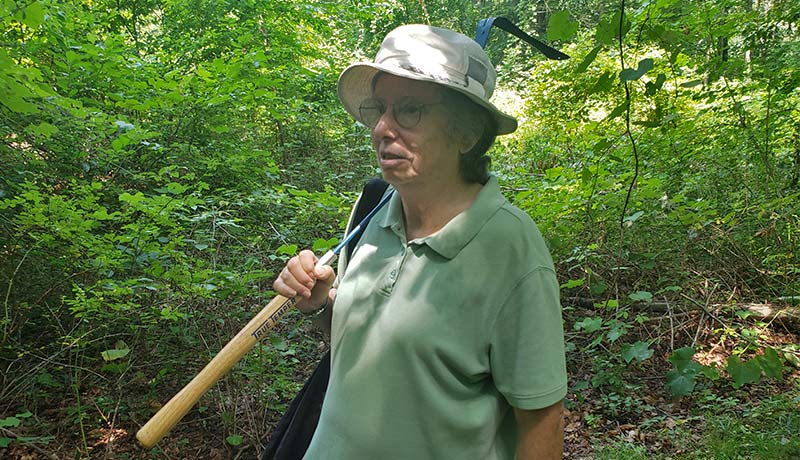
Maryknoll Sr. Doreen Longres looks over part of her community's conservation easement in Ossining, New York. (Photo by Chris Herlinger)
The conservation easement became a centerpiece of the congregation's 100th anniversary. Sisters who shepherded the land-use decision from the idea stage to the final agreement credit the late Sr. Janice McLaughlin, who was congregation president at the time, for her leadership.
Sr. Doreen Longres, who was then co-director, with Sr. Janet Miller, of the congregation’s environment office, said there were discussions within the congregation about how to align practical environmental concerns — about the physical plant and food service, for example — with the sisters' growing commitment to protecting the Earth, but no dissent about the larger commitment to protecting part of the property.
"Some things we were able to do," Longres said. "Some things we were not able to do. Much time was spent on figuring out how we could respond."
Under the agreement with the land trust, the Maryknoll property could still be sold in the future. The area that was chosen for the conservation easement does not include existing buildings, which could be sold in the future or converted for another use.
The congregation's commitment to land conservation stems from the influence of Catholic writers and thinkers such as the late Jesuit Fr. Pierre Teilhard de Chardin and the late Passionist Fr. Thomas Berry, who advanced an environmental consciousness. The sisters' experiences working with Indigenous communities outside the United States deepened their commitment to ecological issues.
Longres' advice to congregations considering land conservation is to educate the members of the congregation and even employees: "Pay attention to the education of your membership, [engage in] reflection on things, sponsor workshops that would expand their thinking about the environment."

For the Dominican Sisters of Hope in Ossining, New York, the forested bluff where they live overlooking the Hudson River about 40 miles north of New York City is not property. "It's the land we hold in common," Dominican Sr. Bette Ann Jaster said, "and it's not just for us."
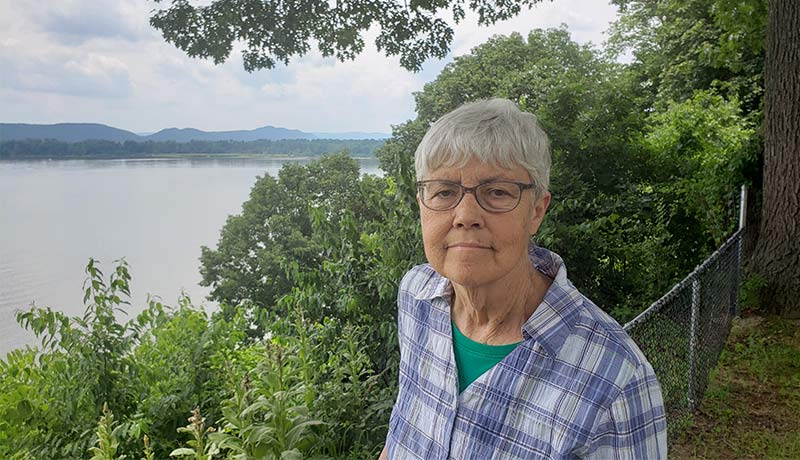
Dominican Sr. Bette Ann Jaster stands on part of the Mariandale property overlooking the Hudson River. (Photo by Chris Herlinger)
The 61-acre property, called Mariandale, includes woodland, a quarter-acre garden and a labyrinth that visitors use for contemplation and meditation. In September 2018, the congregation announced an agreement with the Westchester Land Trust to protect 34 acres of the property as a conservation easement.
At the time, the congregation said the trust "retains the obligation to ensure that the terms of the conservation easement are honored forever." The sisters retain property rights and continue to oversee and manage the part of the property covered by the easement, as well as their Mariandale retreat and conference center.
Jaster said the decision to protect the land was relatively easy because care for creation has long been a core value of the congregation, which was formed in 1995 by the merger of three Dominican communities based in Fall River, Massachusetts; Newburgh, New York; and Ossining.
"Our current Dominican Sisters of Hope have a mission statement that says, 'We're called to preach the Gospel to our world in communion with all creation. We commit our lives to the transforming power of hope,' " Jaster said.
Over the years, as the sisters' numbers began declining, they realized they would need to do something with their land.
When one of the sisters attended a public meeting in the village of Ossining and someone remarked, "Those nuns are going to be gone, and then we'll get that land and make it into a shopping center," they decided to take action.
They initially considered building low-income housing, but village officials opposed the idea, and the sisters also realized that such housing would require a parking lot — something that didn't seem compatible with land preservation.
They formed a land committee and researched options. The fact that three congregations had come together to form a new group paved the way for consensus building. They also had the example of the nearby Maryknoll Sisters, who had established a conservation easement in 2012.
The decision to enter into an agreement with the land trust seemed compatible with what the congregation sought to do: preserve the land for visitors and, longer term, for all of creation.
Noting the ever-present pressure to develop property in and around Ossining, Kara Hartigan Whelan, vice president of the Westchester Land Trust, said when the agreement was reached, "It's a really strong gift. It's a selfless gift." She added, "These acres will never, ever be developed."

A large expanse of grassy, undeveloped land at the foot of imposing Hook Mountain in the Hudson Valley would be prime real estate for development were it not for the Sisters of Our Lady of Christian Doctrine, a community of women religious based in the area for nearly a century.
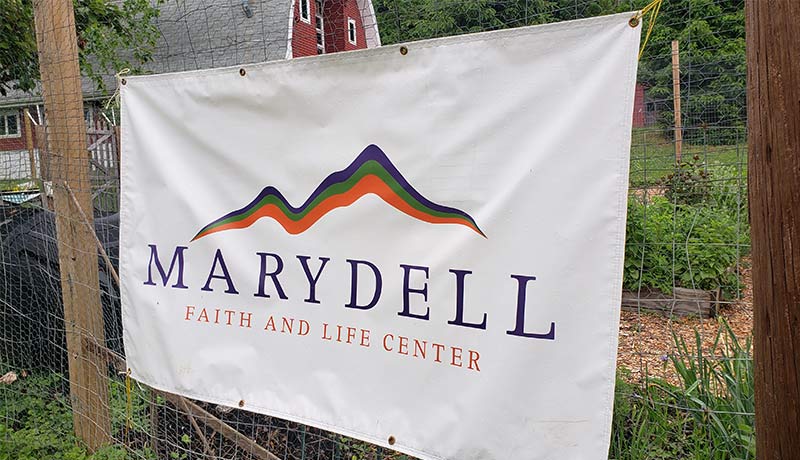
The Sisters of Our Lady of Christian Doctrine have put 30 of their 40 acres in Upper Nyack, New York, into a land trust. (Photo by Chris Herlinger)
The congregation's Marydell Faith and Life Center, located in Upper Nyack, New York, sits on 10 acres of land that was once a summer camp for children from New York City. The camp was an extension of the ministry of the congregation's foundress, Marion Gurney, who worked in New York City in the early 1900s as immigrants poured into the overcrowded urban area.
"Our foundress was a person who loved nature, creation, animals and obviously found God in all of these things," Sr. Verónica Méndez said. But Gurney wanted to share that love with others, "and would see to it that the children got out of the city in the summer."
Marydell was the site of a summer camp for girls from 1928 to 1988, when congregation members, feeling they didn't have the energy needed to run the camp, closed it.
The 10-acre site reopened in 1990 as the Marydell Faith and Life Center, serving as the congregation's convent, also offering cabins, commodious meeting spaces and a swimming pool to groups of all kinds and faith traditions that use the center for meetings and retreats.
But with aging members and few women entering religious life, the congregation faced a dilemma about what to do with another 30 acres that it had acquired over time, which adjoined Nyack Beach State Park.
"What was obvious from the beginning was that we're not going to sell this for money to rich people to build mansions on this prime property," Méndez said.
They found allies among their immediate neighbors, who also wanted to see the land preserved. Several joined the Marydell board of directors as the sisters explored what to do. At the center of worry over future development was that new homes could stress local sewage systems, posing a threat to the Hudson River and that "animals wouldn't have a place to roam anymore," Méndez said.
Eventually the nonprofit, San Francisco-based Trust for Public Land purchased the 30 acres for $3.1 million, with considerable funding from New York state agencies and other governmental and nongovernmental entities. The trust then transferred the land to the state of New York for inclusion in Nyack Beach and Rockland Lake state parks.
The sisters kept 10 acres for Marydell's continued use. In the future, if the congregation ceases to exist and the center cannot continue to operate, the agreement allows for the buildings to be torn down and the property to remain as part of the protected area — a gift returned to the community, Méndez said.

A quarter century ago, religious congregations with ties to New York's Hudson Valley formed a coalition called Religious Organizations Along the River, or ROAR. Initially, the group focused on education and advocacy on key environmental issues, including fracking, the closure of the Indian Point nuclear power plant and a proposed electrical line that would pass under the river to connect electrical suppliers in Canada with the New York metropolitan area.
"ROAR helps us think collectively as a faith-based voice in terms of our relationship to the Hudson River and its bioregion," said Sr. Carol De Angelo, director of the Office of Peace, Justice and Integrity of Creation for the Sisters of Charity of New York, one of ROAR's founding congregations.
ROAR members write to elected officials, speak before church groups and assemblies and have sometimes joined peaceful protests to raise public concerns about issues. They also collaborate with other Catholic social justice groups and secular grassroots activists in the Hudson Valley.
Commitment to safeguarding the Hudson Valley has led some congregations to take steps to conserve parts of their land. That can be a serious decision for groups whose average age is increasing as their numbers decline. Valuable real estate could be sold in the future to offset costs of caring for older members. Nevertheless, some groups have opted to establish conservation easements that protect their land against future development.
Maryknoll Sr. Doreen Longres calls the coalition "a very rich group" that contributed to her congregation's decision to place a substantial amount of their property in Ossining, New York, into a land trust. She credits ROAR with helping her and others focus their ideas through its land-use handbook, workshops and networking with other groups.
Maryknoll Sisters
Dominican Sisters of Hope, Mariandale
Sisters of Our Lady of Christian Doctrine, Marydell
That permanence, though, has also led some congregations to give pause to the idea of easements.
While the Franciscan Sisters of Perpetual Adoration established an easement at their Prairiewoods Franciscan Spirituality Center in Iowa, they have not made the move with the 200 acres surrounding their St. Joseph Villa retirement home outside La Crosse, Wisconsin. (The Franciscan Sisters of Perpetual Adoration are major funders of EarthBeat, and established the Laudato Si' Fund to help endow NCR's coverage of the climate crisis.)
Some sisters worry that an easement would restrict options for younger sisters, who might want to be able to sell the land in the future for funds to support themselves. Another concern has been whether an easement would limit what the sisters themselves can do with the land.
For now, the congregation has decided to set aside 92 acres in perpetuity as part of a collaborative sustainability education project where people in the local community can apply for small parcels of land to grow their own food.
"I just believe this whole thing of when things are ready to happen, they will happen," said Sr. Sharon Berger, a member of the congregation's land review committee. "And one of the things is, we have tried really hard not to push without having support from the sisters. Otherwise, it doesn't work. It just doesn't work."
Education has been key for moving conservation easements from the idea stage to completion, say sisters whose congregations have completed the process. Those efforts cover not only what an easement is, but how it works, who enforces it and the costs it entails. Some land trusts request or require a donation, sometimes around $10,000-20,000, to fund oversight. Landowners may also be responsible for other maintenance costs.
Even when members of a congregation share the value of caring for creation, decisions about land are rarely made quickly. More often, they have emerged from years of reflection and discussion among the sisters.
A representative of the Nebraska Land Trust told Kuper of the Sisters of Mercy that it takes about seven years for the idea to become a reality, not just because of the process, but because it takes time to get everyone on board. As it turned out, it was closer to a decade for them.
For others, the process has evolved in just a couple years. For some congregations, documents like a land ethic or conservation statement developed years earlier proved key in moving forward when an easement was later proposed.
In the Hudson Valley, the conservation easements have emerged from religious congregations' longstanding involvement in environmental activism. Various communities joined together to form a coalition called Religious Organizations Along the River, or ROAR, founded in 1996. The members have been involved in advocacy and educational efforts on issues related to fracking, the expansion of gas pipelines along or under the Hudson River and operation of the Indian Point nuclear power plant north of New York City.
"While each of our congregations are doing things individually as a congregation, the collective voice of ROAR is also a great strong voice," said Sr. Carol De Angelo, director of the Office of Peace, Justice and Integrity of Creation for the Sisters of Charity of New York, one of the original ROAR members.
"We're just one little drop in the ocean there, but I think that the faith voice needs to be made," she said. "It is a witness. It is a witness that people of faith, especially Catholics, are concerned about these issues."
Back at Maryknoll, along the woodland path, Longres, who was co-director of the Maryknoll Sisters' environmental office in 2012, paused to take in the peace and tranquility of the forest around her and reflect on her congregation's decision to protect the land.
"It does feel good," said Longres, a missionary in Peru who was at the Maryknoll Center for much of the summer. "We did a good thing."
Rules about and options for land conservation vary by state and sometimes by county, so there's no single formula. But communities that have made land-use decisions offer some general recommendations.
Sometimes the catalyst is a community decision, but often the idea is nurtured by one or two members of the community. Sisters who have gone through the process recommend getting to know the history and characteristics of the land, developing a land-use vision, and raising awareness and educating members of the congregation. Learn about state and local zoning regulations and find advisers with knowledge of land-use options.
Contact local conservation organizations and land trusts and research their values and how they operate, to ensure that the one chosen aligns with the community's values. One way to do that is to look at lands they have already preserved. Consider the various possible options, which may include sale or donation to a land trust or other conservation organization, creation of an easement or including restrictions in the deed.
Keep the community's future needs in mind when deciding how much of the land, and which parts, to protect, and remember that it can happen in stages. Keep leadership and the wider community updated, and have the community's lawyer review any legal agreement before signing.
The Maryknoll Sisters who protected part of a wetland on their property near Ossining, New York, were one of the first congregations in the Hudson Valley to create a conservation easement. This is a general overview of their process:
General Assembly of sisters decides to incorporate ecology into congregational life.
ROAR founded, with Maryknoll Sisters among the original congregations.
General Assembly endorses Earth Charter.
Environmental desk (later environmental office) created, operating until 2014.
Environmental resource assessment by consultant results in suggestions regarding land management, recycling, paper use and cleaning supplies.
Ongoing education of members.
Congregation approves land ethic that states: "We are called to relearn our place in the universe and be enlightened by a worldview in which land once again is seen as sacred."
Congregation meets with Westchester Land Trust attorney and begins informal discernment about land conservation. Informal meeting with neighbors.
ROAR publishes land use handbook used by Maryknoll Sisters and other groups.
Discernment about land issues continues.
Discernment continues, with consultation of congregational leadership and treasurer, meetings, reports and updates to members.
Multiple walks with land trust personnel to determine easement boundaries.
Tentative boundary marked using GPS plotter.
Official land survey conducted and legal boundary staked.
Easement agreement drafted and reviewed by congregation's lawyer.
Leadership officially approves agreement.
Public announcement of conservation easement agreement.